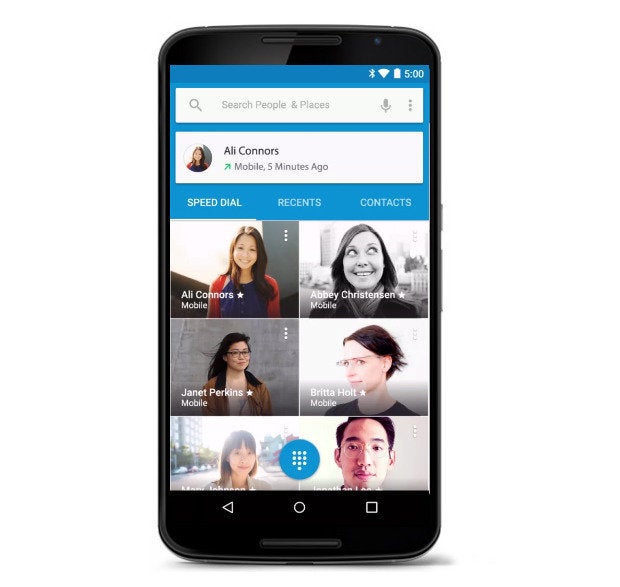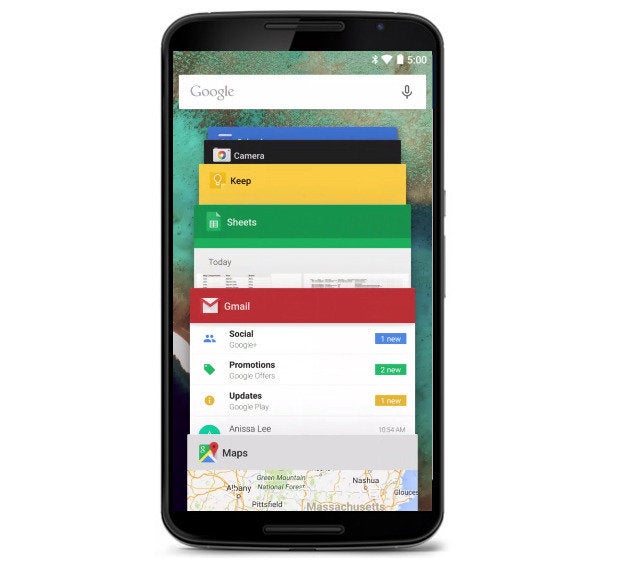Holy confection affection, Android fans! Google's latest version of Android -- Android 5.0, a.k.a. Lollipop -- is at long last unwrapped and on its way into our lives.
Google announced Lollipop along with a trio of new Nexus devices on Wednesday. So what's Lollipop all about, and what'll it mean for you? Here are answers to all of your most pressing questions.
[SEE ALSO: Android 5.0 deep-dive review: Exploring Lollipop's many layers]
What are the five most interesting new features in Android 5.0?
Ooh, I do love counting. These are the ones that have me most intrigued so far:
- Always listening. As in, being able to say "Okay, Google" even when your device's screen is off and then have it wake up and respond to your voice commands. I've gotten used to having that sort of functionality on the Moto X, and I really miss it when I move to other phones. (The feature won't be quite as powerful as what we see on Moto's own devices, but it'll be in the same general ballpark, at least.)
- Tap or move to wake. We've seen this sort of thing on certain manufacturers' phones before, but Lollipop will natively allow devices to wake up either when you move them -- in which case they'll show you a quick peek at your notifications -- or when you double-tap their displays. Handy stuff.
- Priority mode. Android 5.0 will allow you to activate a new quiet mode in which only certain preselected people and types of notifications will get through and generate alerts. You'll be able to turn it on via your device's volume key or by scheduling specific recurring quiet times (like overnight hours) in advance.
- Multiple user support. We've had multiuser support in tablets since Android 4.2, but with Lollipop, the capability comes to phones as well -- and gets an extra boost of power all around. With Android 5.0, you'll be able to let friends and family sign into your phone either in a limited-use guest mode or with their own Google accounts. In the latter instance, they'll even be able to make calls and access messages as if they were on their own personal phones. Wild stuff, eh?
- Smarter notifications. Lollipop has a bunch of cool improvements to notifications -- an area that's always been one of Android's strengths. The system will now feature "intelligent notification ranking," in which notifications are prioritized based on what they are and from whom they're sent. You'll also be able to manually set specific apps to be high-priority or "sensitive" in nature (think dating apps or any, ahem, photo-swapping services you might have on your phone). And the platform features a new type of "heads-up" notification in which things like phone calls and messages briefly appear in a floating box at the top of the screen, so you can quickly view and even act on them without having to open your notification panel.

What about appearance -- how will Lollipop look different?
How, indeed. Lollipop introduces Android's new Material Design theme, which brings a fresh look filled with flat elements and bold, prominent colors. We've already started to see signs of it pop up in certain Google apps, like Google+ and the Play Store, and soon, it'll be at the core of Android itself.

Aside from the new motif, Android 5.0 brings about a bunch of tweaks to specific system elements. The Quick Settings panel built into the top-of-screen notification pulldown, for instance, gets a full makeover and gains new options like a native flashlight function (finally!). The Lollipop lock screen ditches the ability to use widgets (pour one out for our fallen homies) and instead introduces the ability to interact with notifications right then and there. And Lollipop's Recent Apps interface has a whole new look that's card-based and makes multitasking more like tab-switching in a mobile browser (hmm...).

How 'bout performance, Mr. Wizard? Anything new or improved there?
Is there ever, my curious compadre. We won't get too technical here, but Lollipop brings in a new Android runtime that's supposed to provide a smoother overall user interface and faster all-around performance -- up to four times better than what we've seen before, according to Googlers and Googlettes. It also enables support for powerful 64-bit devices, like the new Nexus 9.
And speaking of power, Android 5.0 has a bunch of improvements in the realm of battery life, including a new native battery-saver feature that can give you an extra 90 minutes of use when you need it. There are also some noteworthy improvements to connectivity, which -- among other things -- should make it more seamless to switch between Wi-Fi and mobile networks without any service interruption.
What's new with photos and video in Android 5.0?
My, you certainly know how to ask the right questions. Photo enthusiasts will be pleased to see that Lollipop enables native support for raw image formats like RAW (creative naming there, fellas) and YUV. It'll also support native playback of 10-bit 4K video, if that sort of thing floats your boat.
For the audiophiles among us, Android 5.0 enables lower-latency audio input for applications, multi-channel audio stream mixing (up to eight channels, for apps that get into that), and support for USB mics, speakers, amps, and mixers.
Okay, that's all well and good -- but enough with the fancy-schmancy bells and whistles. How about something new with security?
Sure thing, Sancho: Android 5.0 turns on device-level encryption by default, for one. It has a handful of under-the-hood improvements to protect you even more from the (practically irrelevant but always scary-sounding) threats of malware. And, perhaps most immediately noticeable, it introduces a new "Smart Lock" feature that'll let your phone remain unlocked anytime a trusted Bluetooth device is nearby and connected (similar to what Motorola's been offering on its phones for a while now).
Lollipop will also come with an optional "factory-reset protection" that'll require you to enter your security pattern or PIN as well as your Google ID and account password before your device can be reset. The idea is to make the phone useless -- and thus less enticing -- to thieves. For now, though, the system will be opt-in only.
Is there anything that sounds boring but is actually still important with Android 5.0?
Naturally: There are enhancements to things like accessibility, with better support for low-vision and color-blind users, and added system-wide support for 15 new languages -- including Icelandic! Hvernig væri þá epli?
So tell me: Will my phone or tablet get Lollipop? And if so, when?
That's the million-dollar question, isn't it? As usual, it's up to each manufacturer to provide the upgrade to its phones and tablets -- and as usual, only a few manufacturers have come forward with info on their plans so far.
 Louis Gray
Louis Gray As you'd expect, Google has said it'll update its current crop of Nexus devices -- including the Nexus 4, Nexus 5, Nexus 7 (2012), Nexus 7 (2013), and Nexus 10 -- along with all of its Google Play Edition devices. There's no specific word on timing, but Google's rollouts typically happen pretty quickly after a new release is launched (which, remember, hasn't actually occurred just yet with Lollipop).
Motorola, meanwhile, plans to upgrade its Moto X (first- and second-generation), Moto G (first- and second-generation and LTE model), and Moto E along with its current Verizon Droid devices (Ultra, Maxx, and Mini). Again, no specific timing promises yet, but Motorola tends to be pretty darn fast with upgrades -- especially with its own Moto-branded phones.
Last but certainly not least, HTC has pledged to update all of its HTC One (M8) and One (M7) variants within 90 days of Lollipop's formal release.
[UPDATE: Sony has just announced plans to bring Android 5.0 to its "premium Z series" of phones starting in 2015.]
As for everyone else, well, you might want to read this.
Will all the features and changes you mentioned come to my device?
Not necessarily. First of all, a couple of the features are hardware-dependent -- specifically, the "always listening" and tap-to-wake options. So those may or may not be available on all phones or tablets, depending on if their hardware can support it.
Beyond that, Android's open nature means manufacturers can modify the software in different ways and put their own individual stamps on it. If you want the software as Google designed it, a Google Nexus device is the way to go. Motorola Moto devices are another solid option, as they stick with Google's core Android interface and merely add a handful of noninvasive features on top of it.
Other manufacturers do their own things -- which can be both good and bad, depending on the specific nature of the thing and what type of experience you prefer. But they don't always include everything Google's core software offers. For better and for worse, that's part of what you get when you purchase their products -- and it's something you have to think about when you decide which type of device is right for you.
How do you pronounce "FAQ," anyway? Is it "fahk" or "eff-ay-cue"?
Neither; it's "spork."
How many licks does it take to get to the center of Android Lollipop?
Five, obviously.
If someone made an Android Lollipop with a Tootsie Roll center, would you eat it?
All right -- I think we're done here.















